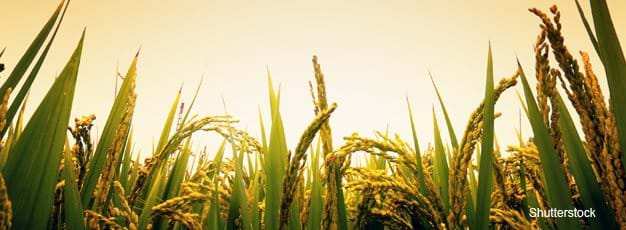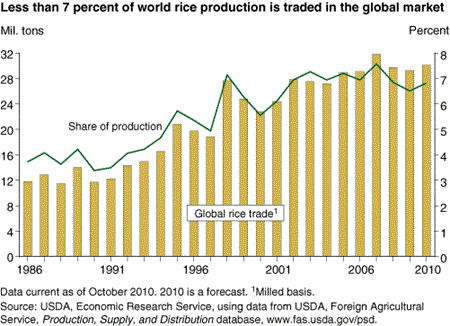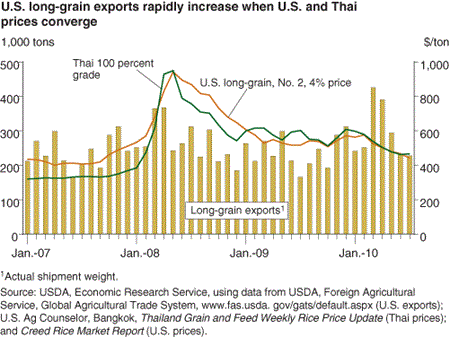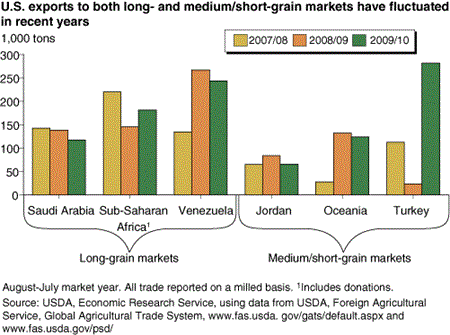Price Spikes in Global Rice Markets Benefit U.S. Growers, at Least in the Short Term

Highlights:
-
Because only a small share of production enters the global market, the world rice market remains susceptible to substantial price volatility.
-
Price volatility is exacerbated by trade policies of importers and exporters seeking to protect their consumers from high prices and ensure adequate supplies.
-
For the U.S., this price and trade volatility can translate into short-term export opportunities.
Global rice trade has nearly tripled since the mid-1980s, largely due to market liberalization policies implemented under the Uruguay Round of the General Agreement on Tariffs and Trade (GATT) and the World Trade Organization (WTO). However, the rice trade remains small relative to other commodities. Rice is one of the top food grains consumed worldwide, but just 6-7 percent of global production, on average, is currently traded in international markets, well below the 20 percent of wheat traded, 11 percent of corn, and 35 percent of soybeans.
“Thin” markets—those with fewer sales, such as global rice trade—may exhibit greater price volatility and larger annual variations in trade levels. Given the relatively small global rice market, if a major consuming country has a crop shortfall and needs to import a substantial amount of rice, little surplus exists. Thus, trading prices have to increase sharply to ration limited supplies. The steep increase in prices typically harms the world’s poorest consumers. Likewise, during years of large global supply, prices are likely to be significantly depressed as import demand by importers is limited.
High yields, ample acreage, consistent high quality, and year-round stocks allow the U.S. to be one of the few consistently reliable suppliers of rice in the global market. U.S. rice exporters are able to rapidly boost shipment levels during periods of tight supplies and high prices. But these price spikes bring only short-term benefits to U.S. rice producers; the increased sales volumes can be lost once prices fall to more normal levels. Long-term growth in the quantity of U.S. rice exported is hampered by highly protectionist policies on the part of importers.
Protectionist Policies Contribute to Thin Rice Markets
Protectionist policies, common in Asia, ban or sharply limit imports to protect domestic growers and promote self-sufficiency. Asia’s protectionist policies reflect the importance of rice in consumers’ diets and the lack of a viable substitute in production or consumption. The region accounts for almost 90 percent of global rice production and consumption. In addition, many of these countries have experienced significant food shortages, such as Indonesia and the Philippines in the mid-1960s, often caused by political crises and adverse weather, making food security an important public goal.
Many exporting countries also pursue policies to ensure self-sufficiency. China, India, Vietnam, Burma, and Cambodia, all major or mid-level exporters, produce rice primarily for their own markets, with governments allowing only surplus production to be exported. When faced with tight supply situations, these countries typically ban or limit exports. Thailand and Pakistan are exceptions, since their domestic markets consume less than half their crop, well below the domestic share of other regional exporters. Thailand, the world’s largest rice exporter, has not halted sales since 1973. At that time, the domestic market consumed around 80 percent of a normal level of annual production. China, India, Vietnam, Burma, Cambodia, Thailand, Pakistan and the United States account for more than 90 percent of global rice exports.
| Top 10 export countries | Average annual exports, 2008-10 (metric tons) |
Top 10 import countries | Average annual exports, 2008-10 (metric tons) |
||
|---|---|---|---|---|---|
| Thailand | 9,194 | Philippines | 2,367 | ||
| Vietnam | 5,600 | Nigeria | 1,833 | ||
| Pakistan | 3,346 | European Union | 1,418 | ||
| United States | 3,242 | Iran | 1,390 | ||
| India | 2,569 | Saudi Arabia | 1,120 | ||
| China | 867 | Iraq | 1,055 | ||
| Uruguay | 789 | Malaysia | 1,043 | ||
| Cambodia | 717 | Ivory Coast | 820 | ||
| Egypt | 642 | Bangladesh | 769 | ||
| Burma | 631 | Senegal | 758 | ||
| Subtotal | 27,597 | Subtotal | 12,573 | ||
| Total global exports | 28,696 | Total global imports | 28,696 | ||
| Top 10 share of total | 96.2% | Top 10 share of total | 43.8% | ||
|
Note: Data current as of October 2010. |
|||||
U.S. Consistently Supplies High-Quality Rice
Although the U.S. accounts for less than 2 percent of world rice production, it has ranked as the third or fourth largest exporter since 1995 and accounted for more than 10 percent of global trade in 2009. The U.S. is a consistent supplier of high-quality rice, shipping long-, medium-, and short-grain rice to more than 100 countries. The U.S. is the only major exporter that ships rough rice (unmilled), as the Asian exporters prefer to capture the value added from fully milling the rice.
In most years, growth in U.S. shipments to developing countries is limited (particularly for long-grain milled rice), since U.S. rice is higher quality and typically priced well above similar grades of Asian rice. However, in years of tight world supplies, U.S. shipments of rice to developing countries have soared. In 2007-08, U.S. exports jumped almost 16 percent from the previous year, and again in 2009-10. In both years, the U.S. price difference over Asian competitors declined.
Several factors have enabled the U.S. to become a reliable supplier to world rice markets. The entire U.S. crop is irrigated, and growers plant only high-quality seeds. As a result, annual yield variations are typically less than in Asia, making severe crop shortfalls rare in the U.S. In 1988, for example, a year of severe drought, U.S. yields dropped less than 1 percent.
There also is some acreage—mostly in the Mississippi Delta—that can be shifted to rice production if global demand increases sufficiently. Uruguay and Argentina also export the bulk of their crops but could not significantly expand production or trade without major infrastructure investments in rice marketing.
The U.S. consumes only about half its rice production, leaving large amounts for export. U.S. per capita use of rice is about 26 pounds per year—less than one-eighth the average in Asia where it is a food staple—and is barely increasing.
In addition, the U.S. rice industry maintains private stocks that could be quickly moved into the global market when it is profitable. In contrast, much of Asia’s stocks are in government-held food reserves that are used only for domestic needs. Few exporters except those in Asia and the U.S. keep significant rice stocks, largely due to limited storage capacity.
Global Price and Demand Surges Affect U.S. Growers
In the long run, self-sufficiency programs reduce trade, lower global trading prices and—because of lower prices—make U.S. rice less competitive in most markets. In the absence of protectionist policies, higher global trading prices would signal growers in the U.S. and other rice-exporting countries to grow more rice, leading to increased U.S. exports and world trade.
In contrast, global price and trade instability may periodically benefit U.S. growers in the short run. If rice supplies become tight in Asia, causing regional exporters to halt sales and motivating importers to ratchet up purchases, the U.S. can move more rice quickly into the global market due to its modern and large-scale marketing and transportation system.
In 2007/08, global rice prices rose to record levels, nearly tripling from August 2007 to April 2008 (see “What’s Behind the Surge in Global Rice Prices?” in the September 2008 issue of Amber Waves). World rice prices began to climb in late summer of 2007 as oil prices soared, the value of the dollar declined, and prices spiked for most traded commodities. At the same time, strong income growth in Asia contributed to rapidly rising domestic food prices. Largely in response to the rising food prices, several Asian exporters began to restrict or ban rice sales in early fall of 2007. By April 2008, when global rice prices peaked, India, Vietnam, Egypt, China, and Cambodia had enacted export bans or restrictions, keeping about 40 percent of available global export supplies off the market. Pakistan established a minimum export price, but it was well below global trading levels and had no market impact. Among the major exporters, only Thailand and the U.S. were not restricting trade. However, the Government of Thailand still kept more than 4 million tons of unmilled rice off the market and even talked of creating a regional rice cartel to control trade. Both factors supported high prices.
These export bans and restrictions were the major reason for the record global rice prices in 2007/08. High oil prices, a weak dollar, and a general rise in commodity prices were less important factors. The global supply and use situation for rice did not support prices at reported levels. In fact, global rice production was the highest on record in 2007/08, and only one exporter—Australia—experienced a crop shortfall.
Rapid, large-scale buying in 2008 by several major importers, a response to concerns over food security and the possibility of even higher trading prices in the future, exacerbated the price situation. In the spring of 2008, the Philippines, the world’s largest rice-importing country, announced several massive offers (tenders) to purchase rice but was unable to fulfill them. The Philippines is far more dependent on imports than most Asian countries, importing more than 15 percent of annual consumption. Malaysia and several West African countries also attempted to secure large amounts of rice for immediate delivery to boost stocks, magnifying the already rapid rise in global prices.
U.S. Picked Up Sales in 2007/08 in Sub-Saharan Africa, Middle East…
The combination of export embargoes, a thin market, and large-scale buying by several major importers allowed the U.S. to expand sales in many traditional and nontraditional markets in 2007/08. The quantity of U.S. rice exported in 2007/08 increased almost 16 percent from a year earlier. A major destination for increased U.S. shipments was the eastern Mediterranean, which had largely been supplied by Egypt until it restricted sales. U.S. sales to Turkey and Jordan—the largest markets in the region—rose rapidly. U.S. rice sales to nontraditional buyers such as Israel, Syria, and Lebanon expanded sharply in 2007/08. U.S. sales also increased to Oceania, a market previously supplied by Australia until drought drastically reduced that country’s rice production. U.S. sales to Sub-Saharan Africa rose sharply in 2007/08 as well. Traditional suppliers to the region banned sales, and local governments, concerned over food security, sharply increased purchases.
In the Western Hemisphere, the U.S. found a significant market in Venezuela—not a typical buyer of U.S. rice—in early 2008, a result of tight supplies in South America and concerns over finding a supplier in the region. Venezuela previously purchased most rice from regional sellers. The country remains a top market for U.S. rice. U.S. shipments to Mexico, the largest export market for U.S. rice shipments, soared 12 percent to a record high in 2007/08, as Mexican buyers quickly purchased large quantities of U.S. rice due to concerns over availability and the possibility of even higher prices in the future.
…But the Export Boost Did Not Last
Global production reached a new record in 2008/09, Vietnam fully re-entered the market, massive buying ceased, and overall demand was dampened by the global financial and economic crisis. Rice prices rapidly declined from 2007/08 record highs, even though Egypt and India continued to restrict sales. Prices would have fallen further in 2008/09 without the policy actions of Thailand. In the face of declining global prices, Thailand implemented an intervention buying program in October 2008, purchasing rough rice from farmers at a 20-percent premium. At its peak, the government held about 6 million tons of current and previous crop rough rice off the market. Despite holding substantial amounts of rice in government stocks, Thailand did not restrict private sales, and available supplies were adequate for commercial needs.
With lower prices and larger global supplies, U.S. exports declined, especially for long-grain rice, the dominant type of rice grown in the U.S. Both Sub-Saharan Africa and the Middle East—large global markets for long-grain rice—turned away from U.S. rice in favor of lower priced Asian competitors. The U.S. lost sales even in the substantial Mexican and Central American rice markets, where the U.S. supplies almost all imported rice, as buyers drew down stocks. The total quantity of U.S. rice exports fell 10 percent in 2008/09, with long-grain shipments plummeting 14 percent.
In contrast, the U.S. was able to maintain export markets for its medium/short-grain rice, as Egypt continued its export restrictions and Australian production saw only a minor recovery. Global prices for medium/short-grain rice declined very little in 2008/09, and Oceania, Israel, and Jordan imported record-high amounts of U.S. rice.
Asian Monsoon and El Niño Lift U.S. Exports in 2009/10
The situation reversed again in 2009/10. Weather problems in several major growing areas—most importantly South Asia, Southeast Asia, and South America—combined with policy decisions by major traders, made U.S. rice prices competitive in many markets and increased U.S. sales. The total quantity of U.S. rice exports increased more than 15 percent in 2009/10.
India, the world’s second largest rice producer, suffered a 10-percent drop in production due to an erratic monsoon season. The country did not import any rice, instead using its buffer stocks to offset the smaller production. India maintained its ban on nonbasmati exports, thus supporting global rice prices.
In 2009/10, the El Niño climate pattern and several typhoons caused a 9-percent decline in rice production in the Philippines. To offset this shortfall, the Philippines is expected to import a record 2.6 million tons of rice in 2010. Large tenders by the Philippines in December 2009 temporarily reversed an 18-month decline in global rice prices, enabling the U.S. to expand shipments to Sub-Saharan Africa and the Middle East, where the U.S. faces its stiffest price competition with Asian suppliers.
The U.S. also was able to continue selling rice to nontraditional buyers, especially Venezuela, thanks to severe weather problems in much of South America in 2009 and 2010. Venezuela suffered a devastating drought in 2009 and 2010, but for political reasons did not import the usual quantities of rice from neighboring Colombia. Brazil also turned to the U.S. for rice in 2010, due to a large decrease in domestic production and a smaller crop in neighboring Uruguay—one of its primary suppliers. The long-term sustainability of these markets as U.S. buyers is unknown.
Thailand’s policies continue to support global prices. Thailand maintained its intervention program through October 2009 and then began to phase in a price insurance scheme that provides income payments to producers instead of purchasing rice at above-market prices. However, direct purchases continued as a means to stabilize domestic prices. By the end of 2009, government purchases pushed total stocks to 4.8 million tons (on a milled basis), a 77-percent increase from a year earlier. The Government of Thailand tried to sell these stocks in early 2010 but failed because global prices had fallen substantially below levels sought by the Government. Depending on how the Government of Thailand releases its stocks, global prices would likely decline when Thailand eventually releases these stocks, reducing U.S. competitiveness in some markets.
Free and Open Markets Are Key to Reduced Price Volatility
The U.S. will likely benefit from any production shortfall and policy response—either export bans or rapid buying by major importers. Expanded U.S. shipments of rice into the world market would reduce the harmful impacts of reduced supply availability and at least partially limit price increases. Because rice is heavily consumed in low-income countries, the U.S. role as a residual supplier of rice supports economic welfare in less wealthy regions during periods of market turbulence.
However, the best cure for price volatility and temporary supply shortages is a larger global market that could easily respond to a production shortfall in a major consuming country. In addition, global efficiency would increase and resource use would decline if high-cost producers curtailed output and relied on the global market for rice. Southeast Asia—an extremely competitive rice-growing region—is a likely source for additional exports if global prices and trade were sustainable at higher levels. Although not low-cost producers, both the U.S. and South America would likely export more rice if prices remained high.
Rice Outlook: May 2012, by Nathan Childs, USDA, Economic Research Service, May 2012
Factors Behind the Rise in Global Rice Prices in 2008, by Nathan Childs and James Kiawu , USDA, Economic Research Service, May 2009
Rice, by Nathan Childs, USDA, Economic Research Service, September 2023




